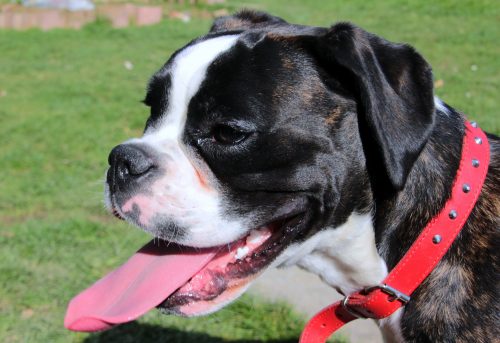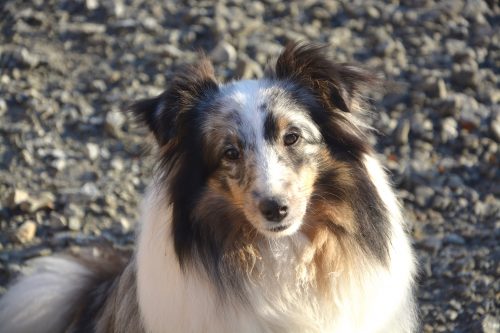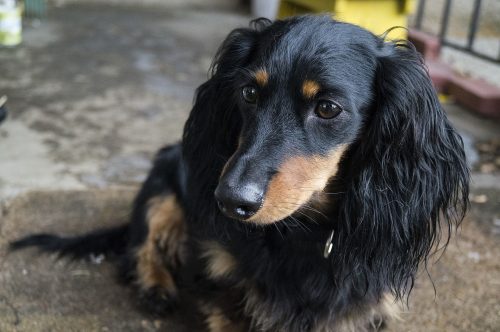It’s a beautiful day. You’re lounging and petting your dog when, just under all the soft fur, you feel some bumps on your dog’s skin under his fur. It’s easy to be alarmed by the sudden appearance of lumps or bumps on your dog.
Your mind immediately jumps to tumors and cancer, but it turns out that lumps and bumps on your dog’s skin can be caused by a wide range of conditions and diseases, most of which are not serious and can be easily treated and cured. Let’s take a look at some of the most common conditions that might be causing bumps on your dog’s skin and how you can treat and prevent them.
Histiocytoma
A histiocytoma is a type of benign tumor, meaning it will not metastasize or spread into surrounding tissue. Histiocytomas originate in your dog’s Langerhans cells, a type of immune cell designed to protect tissues in contact with the outer environment, including the nose, intestines, stomach, and lungs, but they appear most prominently on the surface of your dog’s skin. Langerhans cells are alternately known as dendritic cells or histiocytes.
Histiocytomas are surprisingly common, and over half of the cases reported are in dogs younger than 2 years of age. Some breeds seem to be more predisposed than others, including:
- Bull Terriers
- Boxers
- Flat-Coated Retrievers (ie. golden retrievers)
- Great Danes
- Dachshunds
- Shetland Sheepdogs
- Cocker Spaniels
The main symptom of a histiocytoma is small, firm mass that may be dome- or button-shaped on the surface of your dog’s skin. These masses grow quickly but usually present no pain. They are most commonly found on your dog’s limbs and head and along the edges of a dog’s ears. Rarely, histiocytomas may present as autoimmune blisters that may be ulcerated. Occasionally, your dog may have multiple skin nodules or plaques.
Little is known about what actually causes histiocytomas. Some theories suggest they may come as a result of growth spurts in younger pups.
As certain treatments can have adverse effects on malignant tumors, your veterinarian will perform a variety of tests to make sure that your dog does indeed have a histiocytoma. However, your vet will also give you the option to wait and see what happens as many histiocytomas will heal and go away on their own after about three months.
If the tumor is diagnosed conclusively as a histiocytoma, your veterinarian can remove surgically using either a laser or cryosurgery, which involves freezing the tissue. Both methods are effective and curative.
Lipoma
Another type of benign tumor, lipomas, are subcutaneous, meaning they lie just under the skin. They are generally soft, fatty, and have limited mobility and will not normally affect the overlying skin. Most dogs will develop multiple lipomas, though this does not necessarily point to malignancy or metastasis of the tumor.
Lipomas can grow larger and potentially cause your dog discomfort or impede movement if they are located low on your dog’s chest of between the legs. These tumors mostly appear on your dog’s trunk or belly, but they can show up anywhere.
Infiltrative lipomas are a sub-class of lipomas. These are also benign growths but may still prove to be more troublesome as they invade local muscle tissue and fascia, prompting more immediate removal.
Lipomas should not be mixed up with liposarcomas, which are malignant and can spread to bone, the lungs, and other organs.
Most dogs will not require the lipoma to be surgically removed unless it is causing discomfort or restricting your dog’s movement. If diagnostic tests show that the tumor might be more aggressive, your vet may advise removal of the lipoma. Thankfully, removing lipomas tends to be a simple and straightforward process.
The benign nature of the tumor means that the vet will not have to cut away any healthy tissue surrounding the lipoma. Infiltrative lipoma may require more complex procedures as they are generally found much deeper in the muscle and bone tissue. Infiltrative lipomas may require a combination of surgical excision and radiation therapy for effective elimination.
Mast Cell Tumors (MCT)
Mast cell tumors generally develop in older dogs and are the most common type of skin cancer in dogs. MCT happens when the mast cells in dogs mutate, these lumps can either be not harmful or very malignant and even life-threatening. Just like Histiocytoma, some dog breeds are more susceptible to MCT.
There are three grades of mast cell tumors:
- Grade I – considered benign
- Grade II – behavior of grade II MCTs are unpredictable
- Grade III – clinically aggressive and will spread all over the dog’s body. These can be treated, but even with proper treatment, dog’s may survive less than a year.
Treatment varies depending on the grade of the mast cell tumors. Grade I and Grade II MCTs can be treated by surgically removing them. Though survival rates of dog’s with grade III MCTs are low, an attempt to treat them with surgery and chemotherapy can be made.
Allergic and Irritant Contact Dermatitis
Dog skin conditions can be the signs of an allergic reaction. Yes, even your dog can have allergies. Allergic contact dermatitis is a hypersensitive reaction caused by molecules in your dog’s immediate environment. Substances that may cause allergic contact dermatitis include:
- Nickel and other metals
- Certain topical antibiotics
- Rubber, wool, and other common materials
- Dyes, carpet deodorizers, insecticides, and other chemicals
Irritant contact dermatitis occurs when your dog’s skin is exposed to noxious or irritating substances in the environment. This can include salt on icy roads and sap in poison ivy.
The main difference between allergic and irritant contact dermatitis is that the latter only affects those dogs with a hypersensitivity to the molecule. Irritant contact dermatitis affects every dog. With the allergic form, your dog would have to be exposed to the molecule multiple times before developing a reaction. It is rare in dogs younger than two years old.
The symptoms for contact dermatitis usually involve lesions on places that have very little hair and have made direct contact with the molecules, meaning they are most common on the nose, muzzle, lips, abdomen, and the paws. The lesions often appear as red and itchy with small bumps or vesicles. With irritant contact dermatitis, your dog may develop skin ulcers.
While there isn’t a cure for contact dermatitis, you can help to manage the condition by restricting exposure to any offending molecules in your home and your pet’s immediate environment. That could mean removing or replacing certain objects, like food bowls and dog beds. To control the itching, ask your vet about using topical shampoos, antihistamines, biotin, or fatty acids.
To keep allergic reactions to a minimum, you should consider:
- Using glass or stainless steel bowls for food and water, making sure to clean and rinse them daily
- Regular hypoallergenic shampoos to potentially remove any allergens in your dog’s fur
- Hypoallergenic detergents for your dog’s bedding
- Avoiding grass and sticking with sidewalks and paved surfaces during walks
Cryptococcosis
Cryptococcosis is a fungal infection caused by an environmental yeast known as Cryptococcus neoformans. The fungus is most commonly found in decaying vegetation, particularly Eucalyptus trees, and bird droppings. The fungus is most closely associated with pigeon feces, which contain high amounts of creatinine, creating a desirable environment for Cryptococcus.
In fact, if the fungus is protected from direct sunlight and drying, it can live for up to two years. The fungus can be found all over the world, but areas in Southern California, Australia, and Canada have higher instances of the fungus.
Cryptococcosis is contracted by inhaling the fungal particles. When a dog inhales the particles, they get caught in the nasal passages or lungs. From there, the fungus can spread to the brain, eyes, and other organs and tissues.
The symptoms differ based on the severity of the infection and the organs it actually reaches. The most prominent symptoms involve damage to the nervous system. These may manifest themselves in the form of:
Some common physical symptoms include:
- Skin bumps and ulceration
- A mild fever
- Swollen lymph nodes
- Vomiting and diarrhea
- Nasal discharge
- A loss of appetite
Dogs suffering from cryptococcosis are usually treated with an oral regimen of ketoconazole or itraconazole, common antifungal medications. These medications generally require several months of administration to be effective. However, that long use coupled with the potential toxicity of the drug means you should speak closely with your vet to determine if it is the right treatment option.
Cryptococcosis generally only affects dogs who already have a suppressed immune system. There is currently no vaccine for it, so the best way to prevent it is to avoid areas that may be contaminated with the fungus, particularly areas that see high pigeon traffic.
Canine Acne
As it turns out, even dogs have to deal pimples and zits. Alternately known as puppy dermatitis, muzzle folliculitis, or sebaceous cysts, canine acne appears mainly on the lips, muzzle, and chin, though it can occasionally appear around the belly and genitals. Canine acne only affects puppies and young adult dogs and is most frequently seen in large, short-haired breeds.
There’s no known cause for canine acne, but it’s similar to acne in teenage humans. The pimples start as hard, raised bumps that appear purple or red, while blackheads can crop up in areas with hair follicles. Bacteria then gets into these plugged up pores, creating whiteheads, which are pimples filled with oil and dead skin cells.
Mild acne generally is not uncomfortable or even noticeable, but severe acne can potentially cause pain. The greater danger of canine acne is that your dog may scratch at the pimples, potentially opening them up and increasing the risk of a secondary bacterial infection.
Along with the actual acne, you may notice:
- Mild scabbing
- Inflammation of the hair follicles leading to redness and swelling
- Small skin lesions and bumps
- Blisters
- Furunculosis, which are sometimes referred to as boils, appear as deep, inflamed lesions in the skin and subcutaneous tissues (often a sign of secondary infection)
Treatments for canine acne are aimed towards relieving discomfort, eliminating the potential for infections, and controlling chronic or recurring breakouts. For mild cases of acne, your vet will likely recommend daily cleansing of the affected area with a benzoyl peroxide gel or shampoo. Benzoyl peroxide can be irritating and drying at first and may bleach any fabric, furniture, or carpeting.
Your vet can also recommend creams, lotions, or ointments that can be applied topically to the acne. These may be used in conjunction with the benzoyl peroxide wash or on their own. Be aware that some of these topical treatments may be irritating, greasy, or drying to your dog’s skin and coat.
Your vet may also recommend using a topical glucocorticoid anti-inflammatory medication to reduce inflammation. However, it may also suppress your pup’s immune system, so it should only be used after any secondary bacterial infections have been resolved.
If the bacteria causing the acne or any secondary infections are particularly stubborn, you may have to put your dog on oral antibiotics for up to two months.
It’s also a good idea to keep your dog from touching any affected areas or rubbing his pimples on the carpet or furniture. This will only add further irritation, which can spread the acne more.
As you can see, lumps and bumps on your dog’s skin aren’t always life-threatening, but you should always take your dog to the vet if you notice any strange behaviors or sudden skin problems.
Sources:
- “Lumps, Bumps, Cysts & Growths on Dogs.” PetMD, Accessed10 May 2017. www.petmd.com/dog/general-health/evr_dg_lumps_and_bumps.
- “Skin Lumps and Bumps in Dogs: What You Should Know.” WebMD, Accessed10 May 2017. pets.webmd.com/dogs/dog-lumps-bumps-skin#1.
- “Skin Bumps (Papulonodular Dermatoses) in Dogs.” PetMD, Accessed10 May 2017 www.petmd.com/dog/conditions/skin/c_dg_skin_bumps_masses.
- “Pictures of Skin Problems in Dogs: From Dandruff to Ringworm and More.” WebMD, Accessed10 May 2017. www.pets.webmd.com/dogs/ss/slideshow-skin-problems-in-dogs.
- David, LC. “Dog Skin Rashes: Symptoms, Causes, and Cures.” PetHelpful, 6 Nov. 2017, Accessed10 May 2017. www.pethelpful.com/dogs/Dog-Skin-Bumps-How-to-Get-Rid-of-Your-Dogs-Skin-Rash.








